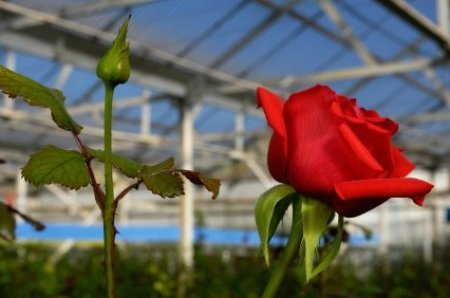A gardener's first rosebush is often an impulse buy. The picture and promise of colorful blooms on the tag draws you in, and before you know it you're on your way home from the store wondering where you are going to find space for it. Growing roses doesn't have to be difficult, but it can be a frustrating experience if it turns out that the plant you buy isn't suitable for your garden. Here are some helpful tips for purchasing rose plants that will give you the best chances for success.
Shopping for rose plants locally allows you to inspect the plants before you buy them. They may be offered bare root or potted. The advantage to potted roses is that they are easy to keep until you are ready to plant them. Look for green, plump, and firm canes with healthy foliage. If the canes appear shriveled or dry, look for another plant. If you can, inspect the root system closely. It should be sturdy and fibrous and contain several firm, well-branched roots.
The best place to shop locally is at a reputable nursery where the staff can tell you which cultivars grow most successfully in your area. Starting with varieties that are safe bets will reduce the risk of loss and let you gain confidence while you cultivate new gardening skills. As an added advantage, many nurseries also offer guarantees on their plants and will replace them if they fail to survive the first year.
A warning about big box stores: The bargain roses you find at big box store may or may not be hardy to your zone. That isn't to say that you're doomed to failure if you plant them, just be prepared for a much higher rate of loss-even if you take extra care to plant them in sheltered locations and give them extra winter protection. Packaged rose plants are often given a wax coating which helps prevent them from drying out during the loss process of shipping and distribution. Unfortunately, the canes treated with wax have a tendency to die back and the wax makes it more difficult for the plant to break dormancy.
There are many mail-order catalogs and online garden retailers that sell rose plants. If you garden in a colder climate, make sure you select varieties that are rated specifically for your hardiness zone and steer clear of vague descriptions like "cold-tolerant" or "winder hardy". Plants that are shipped by mail should be rated as "dormant, two-year-old, #1, field-grown plants" (see rose ratings below). Because you can't inspect the plants in person, pay close attention to the company's shipping and return policies. Most companies will automatically ship at the best planting time for your area' early spring for cool climates, early fall where winters are mild, and winter in very warm areas. Many also offer replacement plants or a money-back guarantee if the plants fail to perform as advertised within the first year.Unless you order miniature roses, your roses will probably be shipped as dormant, bare-root plants (no soil around them). As soon as they arrive, soak the roots in water for 24 hours upon arrival, and then either plant them or wrap them in damp sphagnum moss until you can get them into the ground (within two weeks).
Rose Ratings: According to the official standard, roses that have been budded onto rootstock must be designated a grade of #1, #1 ½, or #2. This rating should be printed clearly on the package of any rose you buy. A #1 grade rose means the plant has at least three vigorous canes that are at least 18 inches high (15 inches for floribundas). Generally speaking, you should always buy #1 grade roses. Their canes and roots will be bigger and better developed than the lesser grades. A #1 ½ grade will have fewer canes but may still be an acceptable choice. Roses with a #2 grade are generally considered weak and inferior compared to others. It's important to note that this rating system does not apply to roses grown on their own roots. They are not required to meet such grading standards.Two other professional designations to look for are endorsements on the packaging by the "AARS" (All-American Rose Selection) or a high rating on a scale of 1 to 10 by the American Rose Society. Although these recommendations generally signal a variety that has been a proven performer, it does not mean that it will automatically perform well in your garden or climate.

About The Author: Ellen Brown is an environmental writer and photographer and the owner of Sustainable Media, an environmental media company that specializes in helping businesses and organizations promote eco-friendly products and services.
Add your voice! Click below to comment. ThriftyFun is powered by your wisdom!